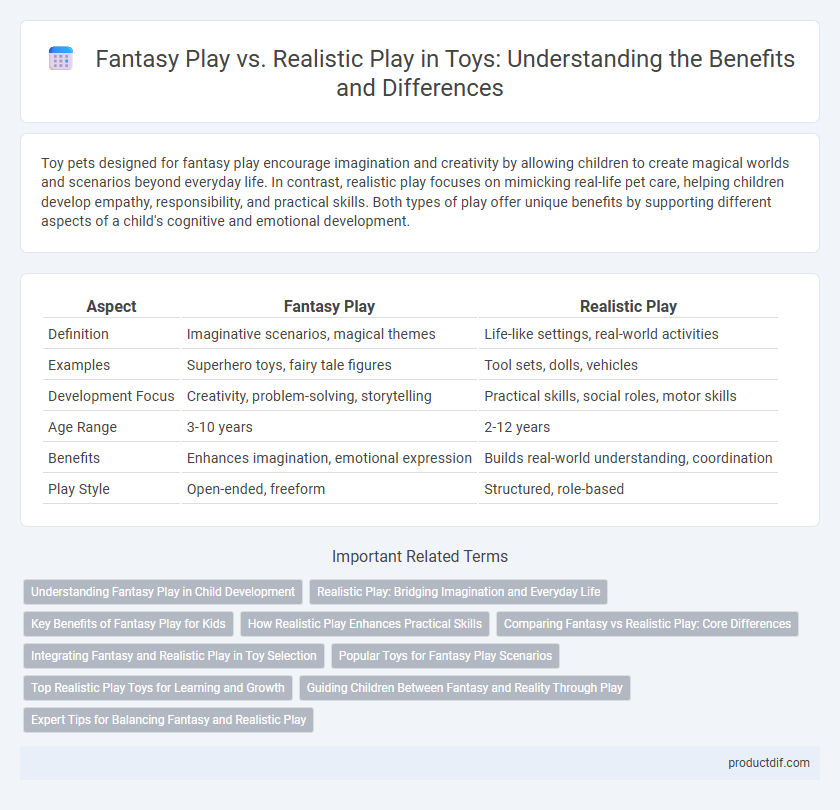Toy pets designed for fantasy play encourage imagination and creativity by allowing children to create magical worlds and scenarios beyond everyday life. In contrast, realistic play focuses on mimicking real-life pet care, helping children develop empathy, responsibility, and practical skills. Both types of play offer unique benefits by supporting different aspects of a child's cognitive and emotional development.
Table of Comparison
| Aspect | Fantasy Play | Realistic Play |
|---|---|---|
| Definition | Imaginative scenarios, magical themes | Life-like settings, real-world activities |
| Examples | Superhero toys, fairy tale figures | Tool sets, dolls, vehicles |
| Development Focus | Creativity, problem-solving, storytelling | Practical skills, social roles, motor skills |
| Age Range | 3-10 years | 2-12 years |
| Benefits | Enhances imagination, emotional expression | Builds real-world understanding, coordination |
| Play Style | Open-ended, freeform | Structured, role-based |
Understanding Fantasy Play in Child Development
Fantasy play in child development fosters creativity, social skills, and emotional expression by allowing children to explore different roles and scenarios beyond reality. Engaging in imaginative activities enhances problem-solving abilities and supports cognitive growth by encouraging symbolic thinking. This form of play contrasts with realistic play, which focuses more on mimicking real-life situations and developing practical knowledge.
Realistic Play: Bridging Imagination and Everyday Life
Realistic play toys like miniature kitchen sets and toolkits enable children to mirror daily activities, enhancing their cognitive development and practical skills. These toys bridge imagination and everyday life by encouraging problem-solving and social interaction within familiar scenarios. Incorporating elements of reality in play supports emotional growth and prepares children for real-world experiences through creative role-playing.
Key Benefits of Fantasy Play for Kids
Fantasy play enhances children's creativity and imagination by allowing them to explore diverse roles and scenarios beyond everyday experiences. It fosters emotional development by helping kids express feelings and solve problems through symbolic thinking. Engaging in fantasy play also improves language skills and social interactions as children negotiate roles and narratives with peers.
How Realistic Play Enhances Practical Skills
Realistic play toys such as pretend kitchens, toolsets, and medical kits enhance practical skills by allowing children to mimic real-life activities, fostering hand-eye coordination and problem-solving abilities. Engaging with these toys helps develop fine motor skills and offers experiential learning opportunities that translate directly to everyday tasks. This form of play supports cognitive growth by encouraging role-based scenarios that strengthen decision-making and adaptability.
Comparing Fantasy vs Realistic Play: Core Differences
Fantasy play involves imaginative scenarios where children create and navigate fictional worlds, fostering creativity and symbolic thinking. Realistic play centers on replicating real-life activities and roles, enhancing practical skills and understanding of everyday environments. These core differences highlight fantasy play's emphasis on imagination and abstract thought versus realistic play's focus on imitation and concrete experiences.
Integrating Fantasy and Realistic Play in Toy Selection
Integrating fantasy and realistic play in toy selection enhances children's cognitive flexibility and creativity by allowing them to explore imaginative scenarios alongside real-world concepts. Toys that combine elements like role-playing costumes with realistic tools, such as doctor kits or construction sets, foster both imaginative storytelling and practical skills development. Choosing toys that balance these play types supports holistic growth by engaging problem-solving, social interaction, and language development through diverse play experiences.
Popular Toys for Fantasy Play Scenarios
Popular toys for fantasy play scenarios include action figures, dress-up costumes, and role-playing sets that stimulate imagination and creativity. Characters from superhero franchises, fairy tales, and fantasy worlds dominate the market, encouraging storytelling and immersive play experiences. These toys foster cognitive development by promoting problem-solving skills and social interaction through imaginative scenarios.
Top Realistic Play Toys for Learning and Growth
Top realistic play toys like building blocks, model vehicles, and interactive dolls significantly enhance cognitive development, fine motor skills, and social interaction in children. These toys provide hands-on learning experiences that mirror real-life scenarios, fostering problem-solving and creativity. Incorporating tools such as pretend kitchen sets and realistic medical kits encourages role-playing, which supports emotional growth and practical knowledge acquisition.
Guiding Children Between Fantasy and Reality Through Play
Fantasy play stimulates children's creativity and imagination by allowing them to explore limitless scenarios, while realistic play helps develop practical skills and understanding of the real world. Caregivers play a crucial role in guiding children to balance both types by setting appropriate boundaries and encouraging reflection on their experiences. This balanced approach enhances cognitive development, emotional regulation, and social competence in early childhood.
Expert Tips for Balancing Fantasy and Realistic Play
Experts recommend blending fantasy and realistic play by incorporating toys that stimulate imagination while reflecting real-world scenarios, such as dollhouses alongside action figures in everyday settings. Providing children with both open-ended fantasy elements and structured realistic tools enhances cognitive flexibility and problem-solving skills. Balancing these play styles encourages creative storytelling and practical learning, fostering well-rounded development.
Fantasy Play vs Realistic Play Infographic

 productdif.com
productdif.com